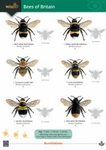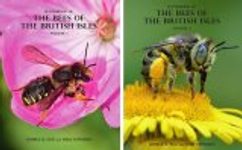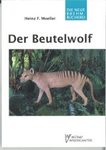Identification Key Monograph
By: Manfred Dorn(Author), Dieter Weber(Author)
112 pages, 1 plate with 3 colour photos; 56 b/w photos, b/w line drawings and b/w distribution maps; 5 tables
![Die Luzerne-Blattschneider-biene und ihre Verwandten in Mitteleuropa: Megachile rotundata u.a. [The Alfalfa Leafcutter Bees and Their Relatives in Central Europe: Megachile rotundata and Others] Die Luzerne-Blattschneider-biene und ihre Verwandten in Mitteleuropa: Megachile rotundata u.a. [The Alfalfa Leafcutter Bees and Their Relatives in Central Europe: Megachile rotundata and Others]]()
Click to have a closer look
About this book
Customer reviews
Related titles
About this book
Language: German
Nowadays the inconspicuous bee Megachile rotundata, rarely seen in the wild, is designated as a "star" among the of Central Europe. This predicated is not to be dismissed out of hand, as Megachile rotundata has gained significant economic importance in recent decades. Like the honeybee kept in special log buildings, it is used worldwide to for pollination of alfalfar. Thus an enormous increase in seed yield was not only achieved, but also an expansion of cultivation areas of this valuable forage plant was made possible. Of the roughly 2000 leafcutter bee species previously known only 26 are native to Central Europe. Some species can be found in parks and gardens searching for pollen and nectar on Papilionaceae or Asteraceae. The attentive naturalist, however, can determine the presence presence of these wild bees in other ways: leaves with characteristic round or oval cutouts indicate that leafcutter bees have been cutting building material for their brood cells. This volume informs the reader about this and other interesting behaviors, biology and lifestyle of alfalfa leafcutter bees and their relatives. By means of a determination table the precise determination of all considered species is possible.
Summary in German:
Als "Star" unter den Wildbienen wird die unscheinbare, in Mitteleuropa als Wildform seltene Luzerne-Blattschneiderbiene heute oft bezeichnet. Ganz von der Hand zu weisen ist dieses Prädikat nicht, hat Megachile rotundata doch in den letzten Jahrzehnten erhebliche wirtschaftliche Bedeutung erlangt. Ähnlich wie die Honigbiene in speziellen Blockbauten gehalten, wird sie weltweit zur Luzernebestäubung eingesetzt. Dadurch wurde nicht nur eine enorme Steigerung der Saatguterträge erzielt, sondern auch eine Ausweitung der Anbaugebiete dieser wertvollen Futterpflanze möglich. Von den bisher bekannten etwa 2000 Mörtelbienen- und Blattschneiderbienenarten sind nur 26 in Mitteleuropa heimisch. Einige Arten können gelegentlich in Parkanlagen und Gärten auf Pollen- und Nektarsuche an Schmetterlingsblüten- oder Korbblütengewächsen angetroffen werden. Der aufmerksame Naturbeobachter kann aber auf andere Weise auf das Vorhandensein dieser Wildbienengruppe schließen: Blätter mit charakteristischen runden oder ovalen Ausschnitten weisen darauf hin, daß Blattschneiderbienen Baumaterial für ihre Brutzellen herausgeschnitten haben. Über diese und andere interessante Verhaltensweisen, über Biologie und Lebensweise der Luzerne-Blattschneiderbiene und ihrer Verwandten informiert der vorliegende Band. Mit Hilfe einer Bestimmungstabelle ist die sichere Determinierung aller berücksichtigten Arten möglich.e
Customer Reviews
Identification Key Monograph
By: Manfred Dorn(Author), Dieter Weber(Author)
112 pages, 1 plate with 3 colour photos; 56 b/w photos, b/w line drawings and b/w distribution maps; 5 tables





![Die Luzerne-Blattschneider-biene und ihre Verwandten in Mitteleuropa: Megachile rotundata u.a. [The Alfalfa Leafcutter Bees and Their Relatives in Central Europe: Megachile rotundata and Others] Die Luzerne-Blattschneider-biene und ihre Verwandten in Mitteleuropa: Megachile rotundata u.a. [The Alfalfa Leafcutter Bees and Their Relatives in Central Europe: Megachile rotundata and Others]](http://mediacdn.nhbs.com/jackets/jackets_resizer_xlarge/55/55389.jpg?height=620)
![Die Luzerne-Blattschneider-biene und ihre Verwandten in Mitteleuropa: Megachile rotundata u.a. [The Alfalfa Leafcutter Bees and Their Relatives in Central Europe: Megachile rotundata and Others]](http://mediacdn.nhbs.com/jackets/jackets_resizer/55/55389.jpg)
![Die Luzerne-Blattschneider-biene und ihre Verwandten in Mitteleuropa: Megachile rotundata u.a. [The Alfalfa Leafcutter Bees and Their Relatives in Central Europe: Megachile rotundata and Others]](http://mediacdn.nhbs.com/jackets/jackets_resizer/55/55389_1.jpg)
![Die Luzerne-Blattschneider-biene und ihre Verwandten in Mitteleuropa: Megachile rotundata u.a. [The Alfalfa Leafcutter Bees and Their Relatives in Central Europe: Megachile rotundata and Others]](http://mediacdn.nhbs.com/jackets/jackets_resizer/55/55389_2.jpg)
![Die Luzerne-Blattschneider-biene und ihre Verwandten in Mitteleuropa: Megachile rotundata u.a. [The Alfalfa Leafcutter Bees and Their Relatives in Central Europe: Megachile rotundata and Others]](http://mediacdn.nhbs.com/jackets/jackets_resizer/55/55389_3.jpg)
![Die Luzerne-Blattschneider-biene und ihre Verwandten in Mitteleuropa: Megachile rotundata u.a. [The Alfalfa Leafcutter Bees and Their Relatives in Central Europe: Megachile rotundata and Others]](http://mediacdn.nhbs.com/jackets/jackets_resizer/55/55389_4.jpg)




![Die Gottesanbeterin (Mantis religiosa) [The European Mantis]](http://mediacdn.nhbs.com/jackets/jackets_resizer_medium/17/178329.jpg?height=150&width=105)
![Die Seescheiden von Helgoland: Biologie und Bestimmung der Ascidien [ The Sea Squirts of Helgoland: Biology and Determination of Ascidians]](http://mediacdn.nhbs.com/jackets/jackets_resizer_medium/20/203911.jpg?height=150&width=108)
![Marienkäfer [Ladybirds]](http://mediacdn.nhbs.com/jackets/jackets_resizer_medium/59/59352.jpg?height=150&width=105)
![Unsere Zuckmücken [Our Mosquitoes]](http://mediacdn.nhbs.com/jackets/jackets_resizer_medium/23/237825.jpg?height=150&width=107)













![Verhalten der Gazellen [Behaviour of Gazelles]](http://mediacdn.nhbs.com/jackets/jackets_resizer_medium/20/203915.jpg?height=150&width=106)
![Das Okapi [The Okapi]](http://mediacdn.nhbs.com/jackets/jackets_resizer_medium/16/164634.jpg?height=150&width=107)








